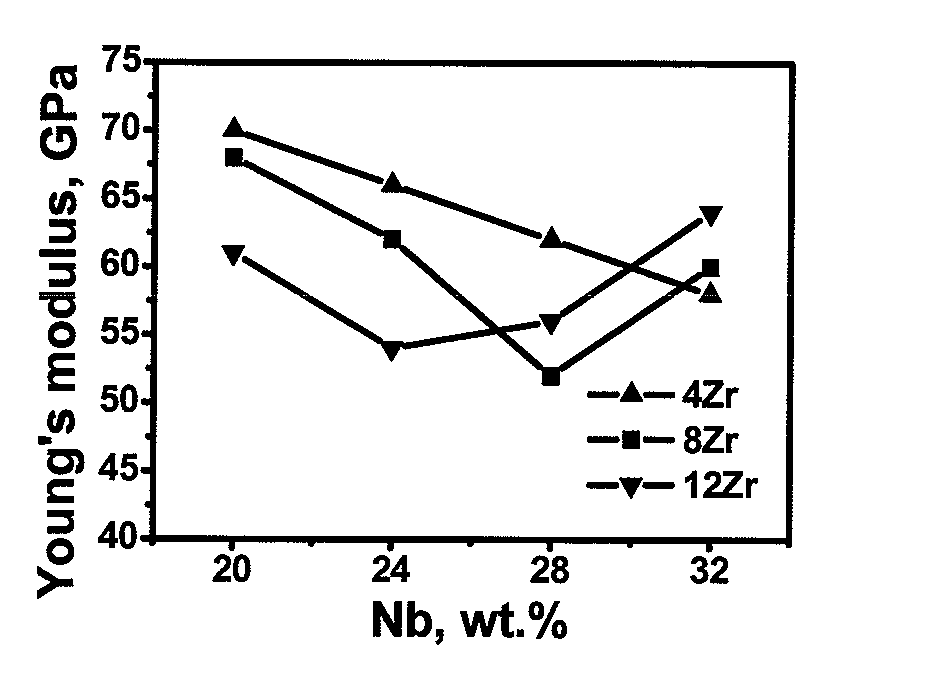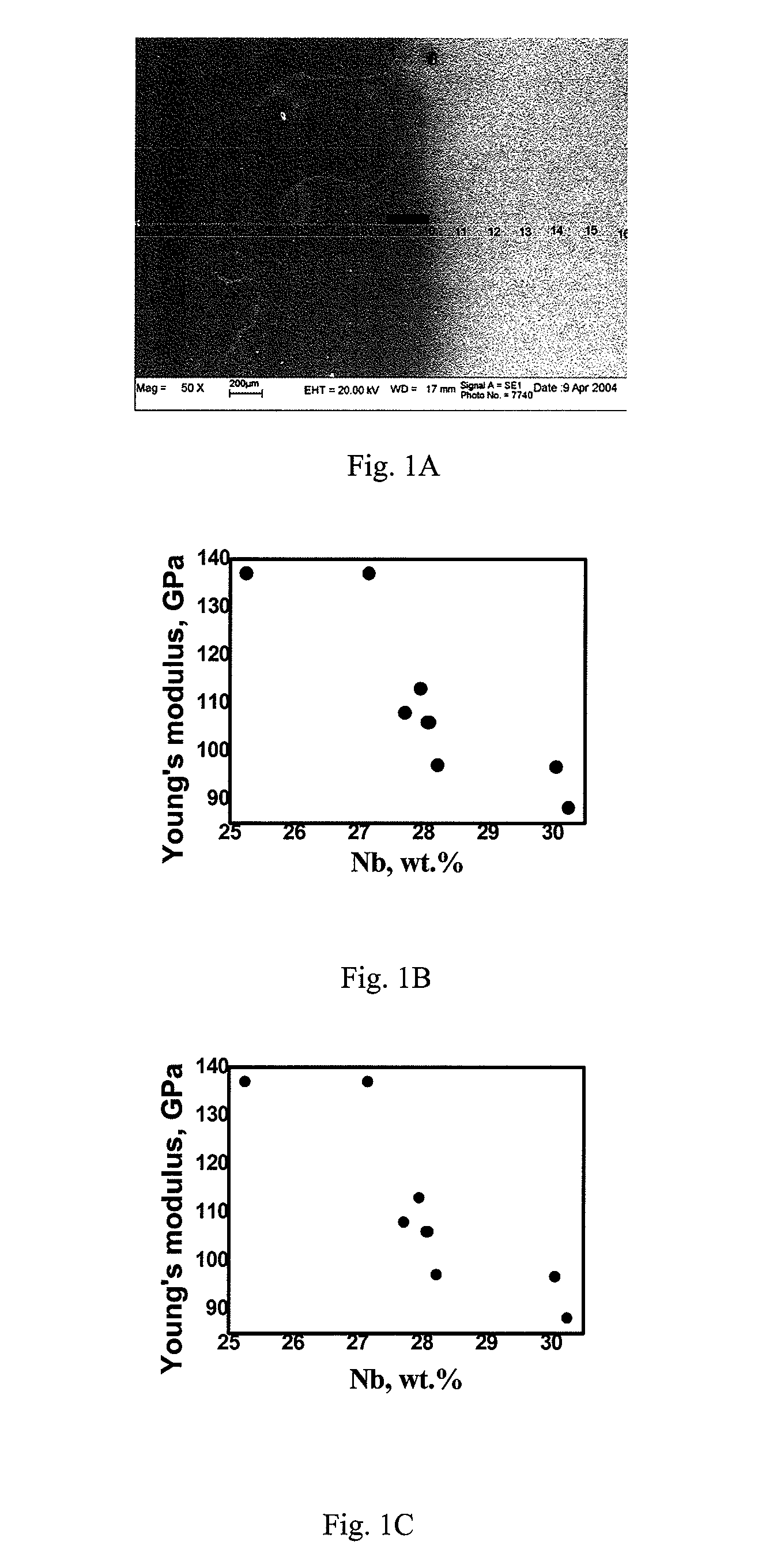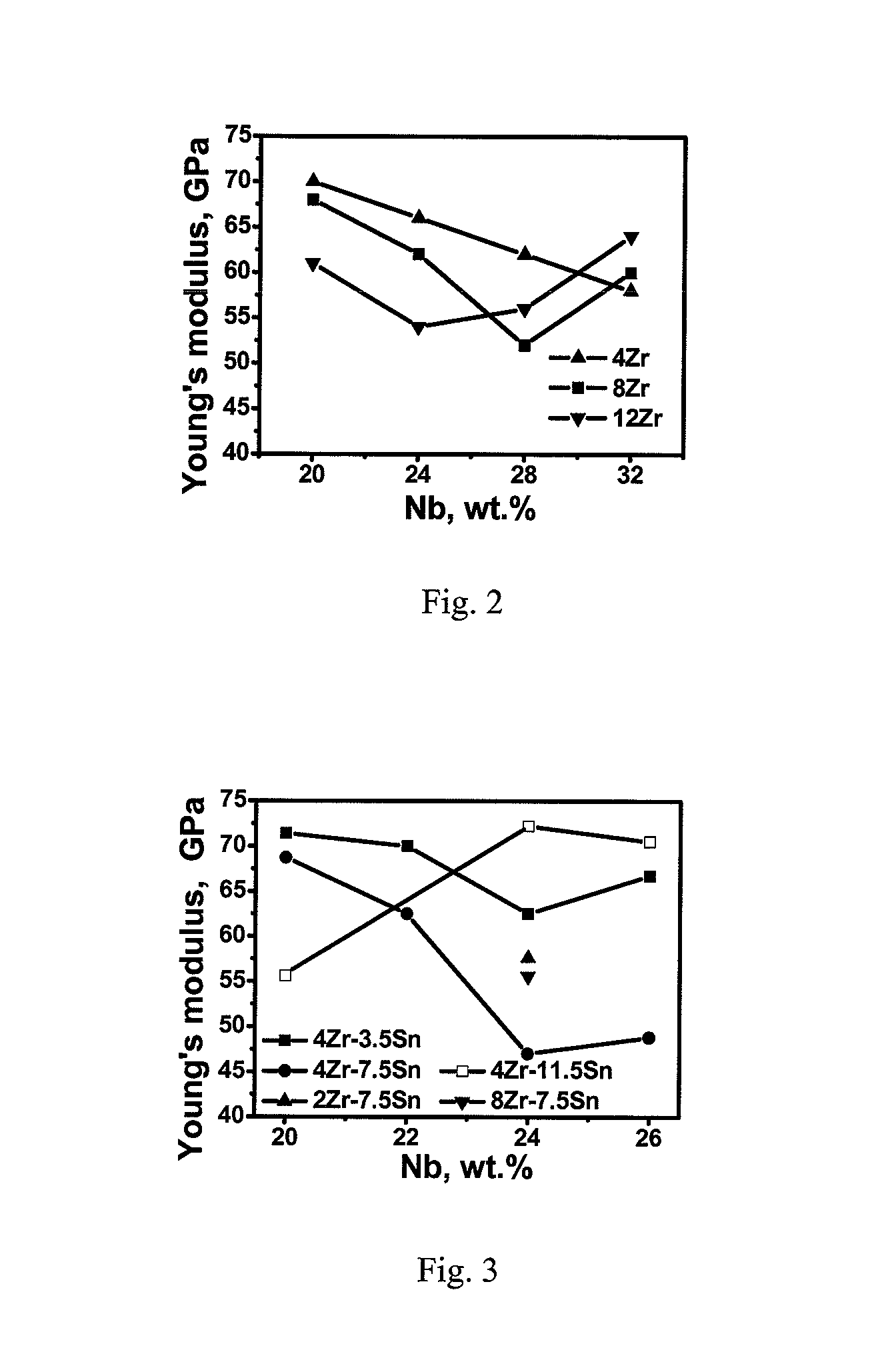Titanium alloy with extra-low modulus and superelasticity and its producing method and processing thereof
a technology of superelasticity and titanium alloy, applied in the field of titanium alloys, can solve the problems of not being able to further investigate alloys, not being able to observe the shape memory phenomena of the above titanium alloy, and not being able to publish and inventions about the superelasticity of these alloys, etc., to achieve high biocompatibility, high strength, and good corrosion resistance
- Summary
- Abstract
- Description
- Claims
- Application Information
AI Technical Summary
Benefits of technology
Problems solved by technology
Method used
Image
Examples
example 1
[0048]The master alloys listed in Table 1 were melted with a non-consumable arc melting furnace with magnetic agitation. To ensure chemical homogeneity, the buttons with weight of 60 g were melted three times. They were forged at 950° C. to bars with cross-section of 10 mm×10 mm and specimens with dimension of 20×6×4 mm were cut. After grinding and polishing, they were diffusion-coupled at 1000° C. for 4 h in. vacuum according to chemical composition listed in Table 1. These couples were heat-treated at 1300° C. for 50 h to obtain diffusion coupled with thickness of more than 1 mm. FIGS. 1A and 1B shown SEM photograph and EDS analysis results of Ti-20Nb-5Zr / Ti-35Nb-5Zr diffusion couple.
[0049]
TABLE 1Chemical composition of Ti—Nb—Zr / Ti—Nb—Zr andTi—Nb—Zr—Sn / Ti—Nb—Zr—Sn diffusion couples (wt. %).Ti-20Nb-2Zr / Ti-35Nb-2ZrTi-20Nb-5Zr / Ti-35Nb-5ZrTi-20Nb-8Zr / Ti-35Nb-8ZrTi-20Nb-4Zr -2Sn / Ti-20Nb-4Zr -5Sn / Ti-20Nb-4Zr-8Sn / Ti-35Nb-4Zr -2SnTi-35Nb-4Zr -5SnTi-35Nb-4Zr -8SnTi-20Nb-8Zr -2Sn / Ti-20Nb-8Z...
example 2
[0052]Differences from Example 1 are as follows. This example is to investigate the effect of alloying on α″ martensite starting transformation temperature and to identify chemical composition range that exhibits high recoverable strain.
[0053]The alloys were melted three times with a non-consumable arc melting furnace with magnetic agitation. The nominal chemical compositions of alloys are listed in Table 2. The melted buttons weighing 60 g were forged at 950° C. to bars 10×10 mm in cross-section. Then the samples were encapsulated in quartz tubes and were solution-treated at 850° C. for 30 min and then air cooled for 20 s followed by quenching in water after breaking. The transformation temperature of martensite to autenite was measured by differential scanning calorimetry (DSC) at heating or cooling rate of 10° C. per minute during the temperature range from −150° C. to 150° C. The results in Table 3 shown that the transformation temperature decreased by about 17.6° C., 41.2° C. a...
example 3
[0058]Ti-28Nb-2Zr-6Sn-2Al ingot with weight of 60 g was melted.three times with a non-consumable arc melting furnace with magnetic agitation. The melted buttons were forged at 950° C. to bars 10×10 mm in cross-section. Then the samples were encapsulated in quartz tubes. Then the sample was solution-treated at 850° C. for 30 min and air cooled for 20 s followed by quenching in water after breaking. The loading-unloading curve in FIG. 10 shown that the alloy with Al addition also has low modulus and good superelasticity.
PUM
| Property | Measurement | Unit |
|---|---|---|
| tensile strain | aaaaa | aaaaa |
| temperature | aaaaa | aaaaa |
| temperature | aaaaa | aaaaa |
Abstract
Description
Claims
Application Information
 Login to View More
Login to View More - R&D
- Intellectual Property
- Life Sciences
- Materials
- Tech Scout
- Unparalleled Data Quality
- Higher Quality Content
- 60% Fewer Hallucinations
Browse by: Latest US Patents, China's latest patents, Technical Efficacy Thesaurus, Application Domain, Technology Topic, Popular Technical Reports.
© 2025 PatSnap. All rights reserved.Legal|Privacy policy|Modern Slavery Act Transparency Statement|Sitemap|About US| Contact US: help@patsnap.com



